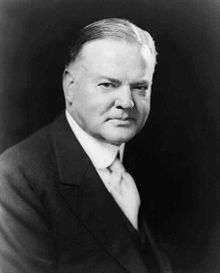American Relief Administration
American Relief Administration was an American relief mission to Europe and later post-revolutionary Russia after World War I. Herbert Hoover, future president of the United States, was the program director.
The ARA's immediate predecessor was the United States Food Administration, also headed by Hoover. He and some of his collaborators had already gained useful experience by running the Committee for Relief in Belgium which fed seven million Belgians and two million northern French during World War I.
ARA was formed by US Congress on February 24, 1919 with the budget of 100 million dollars. Its budget was boosted by private donations, which resulted in another 100 million dollars. In the immediate aftermath of the war, the ARA delivered more than four million tons of relief supplies to 23 war-torn European countries. Between 1919 and 1921, Arthur Cuming Ringland was chief of mission in Europe.[1] ARA ended its operations outside Russia in 1922; in Russia it operated till 1923.
ARA and Poland
About 20% of its resources were directed to the newly established Second Polish Republic. Much of its resources were helping Polish children. ARA however has been criticized by some for aiding Polish soldiers during the Polish-Soviet War. Polish leader Józef Piłsudski has written a note of personal thanks to Hoover; one of the streets in Warsaw has been named after him; he also received honorary degrees from the Jagiellonian University, Warsaw University and Lviv University, among other honors (such as several honorary citizenships of various Polish towns). A monument dedicated to American helpers has been constructed in Warsaw.
Colonel Alvin B. Barber headed the group from 1919 to 1922.[2] Specific areas had directors as well, such as W.N. Haskell, who was Director of the ARA in Romania as of 1919.[3]
ARA and Russian famine of 1921
When the Russian famine of 1921 broke out, the ARA's director in Europe, Walter Lyman Brown, began negotiating with Soviet deputy People's Commissar for Foreign Affairs, Maxim Litvinov, in Riga, Latvia. An agreement was reached on August 21, 1921 and an additional implementation agreement was signed by Brown and People's Commisar for Foreign Trade Leonid Krasin on December 30, 1921. The U.S. Congress appropriated $20,000,000 for relief under the Russian Famine Relief Act of late 1921.
At its peak, the ARA employed 300 Americans, more than 120,000 Russians and fed 10.5 million people daily. Its Russian operations were headed by Col. William N. Haskell. The Medical Division of the ARA functioned from November 1921 to June 1923 and helped overcome the typhus epidemic then ravaging Russia. The ARA's famine relief operations ran in parallel with much smaller Mennonite, Jewish and Quaker famine relief operations in Russia.[4][5]
The ARA's operations in Russia were shut down on June 15, 1923, after it was discovered that Russia renewed the export of grain."[6]
See also
- Marshall Plan
- American Committee for Relief in the Near East
- The President's Economic Mission to Germany and Austria
- Hoover Institution Library and Archives
- GARIOA
- UNRRA
People
- James Stuart McKnight, worked with the agency
Footnotes
- ↑ "Oral History Interview with Arthur Ringland by Richard D. McKinzie". Truman Library. Retrieved 2013-1. Check date values in:
|access-date=(help) - ↑ "Col. Barber Quits Poland. Terminates Services There and Starts for Home". New York Times. August 13, 1922. Retrieved May 30, 2011.
Colonel A. B. Barber, technical adviser to the Republic of Poland for the last three years, who was appointed ... to undertake the mission for Poland, had wide experience to the American Relief Administration to handle ...
- ↑ Kaba, John (1919). Politico-economic Review of Basarabia. United States: American Relief Administration. p. 7.
- ↑ See Lance Yoder's "Historical Sketch" in the online Mennonite Central Committee Photograph Collection
- ↑ See David McFadden et al, Constructive Spirit: Quakers in Revolutionary Russia, 2004
- ↑ Charles M. Edmondson, "An Inquiry into the Termination of Soviet Famine Relief Programmes and the Renewal of Grain Export, 1922–23", Soviet Studies, Vol. 33, No. 3 (1981), pp. 370–385
Additional reading
- A.C. Freeman, "Is Hoover Bringing Russia Food or Reaction?" New York Call Magazine, Aug 7, 1921, pp. 1, 11.
- H.H. Fisher, The Famine in Soviet Russia, 1919–1923: The Operations of the American Relief Administration. New York: Macmillan, 1927.
- Frank Golder, War, Revolution, and Peace in Russia: The Passages of Frank Golder, 1914–1927. Terence Emmons and Bertrand M. Patenaude (eds.). Stanford, CA: Hoover Institution Press, 1992.
- George H. Nash. The Life of Herbert Hoover: The Humanitarian, 1914–1917 (1988) excerpt and text search
- Bertrand M. Patenaude. The Big Show in Bololand. Stanford, CA: Stanford University Press, 2002.
- NN, "Vastness of Hoover’s Work Realized as He Returns," The New York Times, September 14, 1919, pg. 47.
- NN, "Bankers to Handle 'Food Draft' Sales," New York Times, January 22, 1920, pg. 27.
- NN, "$8,000,000 Distributed In Food Drafts for Germany," New York Times, September 7, 1920, pg. 1.
- Frank M. Surface and Raymond L. Bland, American Food in the World War and Reconstruction Period. Operations of the Organizations Under the Direction of Herbert Hoover 1914 to 1924, Stanford, CA: Stanford University Press, 1931.
- Усманов Н.В. Деятельность Американской администрации помощи в Башкирии во время голода 1921—1923 гг. Бирск, 2004; Patenaude B.M. The Big Show in Bololand. The American Relief Expedition to Soviet Russia in the Famine of 1921. Stanford, 2002.
